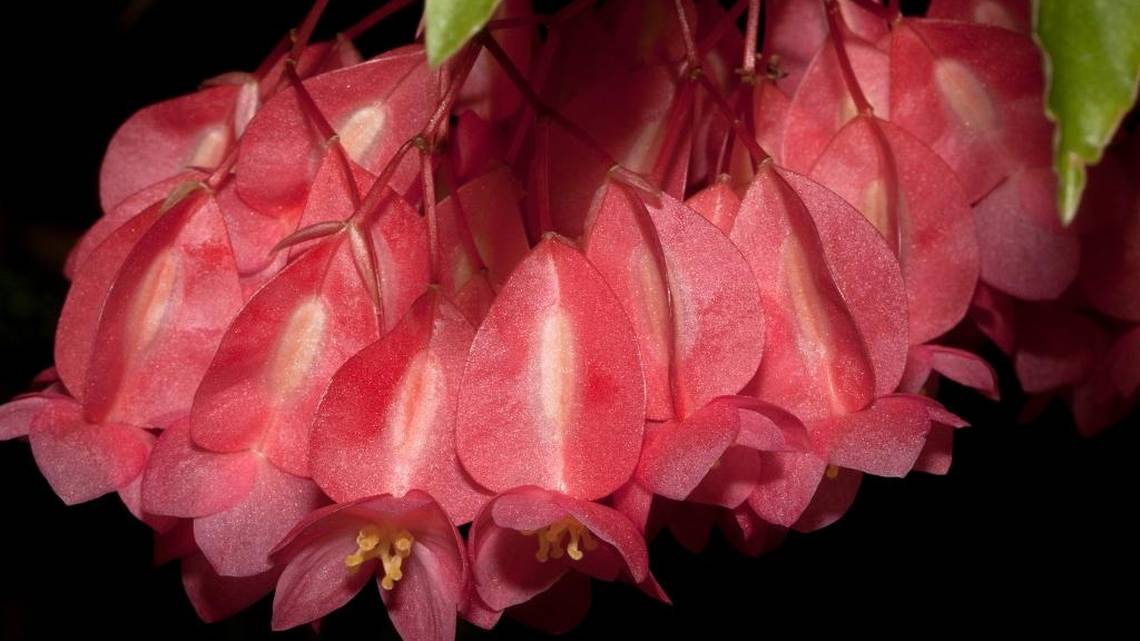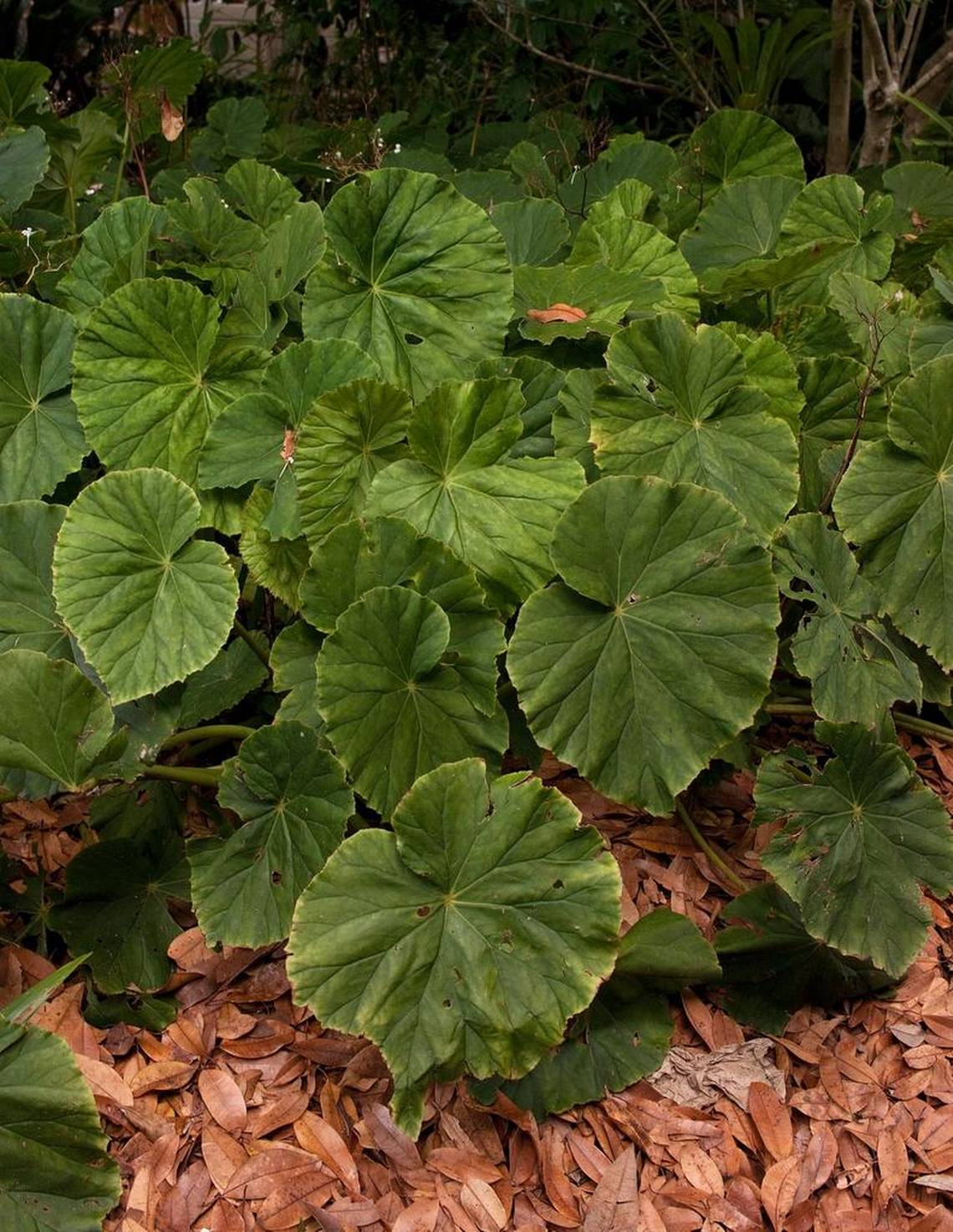What flower is a South Florida gardener’s best friend? Hint: not impatiens

BY KENNETH SETZER
Fairchild Tropical Botanic Garden
As published in the Miami Herald, November 16, 2017 09:00 AM

Flowers of Begonia maculata, an angel wing begonia with white spotted foliage. Kenneth Setzer/Fairchild Tropical Botanic Garden
Bounteous begonias deserve a featured place in our landscaping. Their sheer variety, adaptability and ease of care make them suitable for our subtropical gardens. In South Florida, they are a gardener’s best friend.
Begonias always make me think of a stereotypical grandma’s garden — nice, but not exactly hip. Like most stereotypes, we sustain this one at our loss. Here are some begonia basics for growing and appreciating this amazing genus of plants.
Begonia leaves are usually asymmetric. How cool is that? Symmetry is the rule in nature. Just look at ferns. Divide a fern frond and you have close to a mirror image of each side. Not begonias. Their flowers are also unusual — sepals and petals are often nearly impossible to tell apart, and so are collectively called tepals.
Now if you see an asymmetric leaf, you might reasonably think of begonias, but identifying species and cultivated varieties can be impossible outside a botany laboratory. Their forms can vary from miniature terrarium plants to tall cane begonias with leaves that range in color from shiny solid green to pebbled silver and black or even with an iron cross pattern. There’s just indescribable variety.
In fact there are so many kinds that begonia experts, to aid in classification, place them into botanical sections — 66 of them. Horticulturists place them into eight groups. Briefly, these include Rex, a group grown for its variety and foliage. Rex begonias all grow from rhizomes, as does another: the Rhizomatous group. However, Rex begonias are all descended from Begonia rex.

Begonia popenoei is an easy garden plant. Kenneth Setzer/Fairchild Tropical Botanic Garden
Tuberous begonias can go dormant to survive cooler temps and are known for grander flowers. Rhizomes and tubers are quite similar — underground, modified plant stems that store nutrients. However rhizomes grow horizontally. Semperflorens are “wax” begonias with thick, waxy foliage.
Cane begonias grow tall, bamboo-like stems. Angel wing begonias are one example. Shrub begonias grow, well, shrubby with multiple stems reaching out from the soil. Trailing begonias climb philodendron-like or hang from pots. Thick-stemmed begonias have, predictably, thick stems. They drop lower leaves to look almost arborescent, or tree-like.
These groups are fairly flexible with many plants overarching into multiple groups.
Begonias are native to both the Old and New World tropics, and even those from different continents can be interbred, a factor in the thousands of varieties and hybrids available. Most prefer heat and humidity, though if potted, can rot from overwatering, particularly the tuberous kinds entering cool-weather dormancy. However they do thrive in high humidity, which can be increased by misting (for houseplants) and group plantings.
Some make great landscaping cover, like Begonia popenoei, with gigantic, smooth green leaves a few feet off the ground. It is demure enough to be filler between taller plants and trees while fantastic enough to be a focus with spikes of small white flowers. This one likes plenty of organic matter in the soil and tolerates South Florida sun.
From Mexico and Central America comes Begonia nelumbiifolia, the lily pad begonia, a rhizomatous species with leaves that look like lotus. At a foot or two tall, they look at home accenting garden corners. In my own yard, I grow a Begonia popenoei at a walkway intersection facing west. It’s my favorite type of plant — easy! It gets lots of roof runoff, lots of harsh sun, only rare additions of compost, and it absolutely flourishes.
A bit esoteric is fern-leaf begonia (B.Bipinnatifida), not likely found at local nurseries, which befits its exotic origin in Papua New Guinea. It looks little like a begonia. Shrubby, fern-like, deeply divided foliage is olive green with contrasting wine-red undersides. It thrives in Fairchild’s Rare Plant House, which has a screened ceiling and experiences all but the coldest of our weather, so this plant might be a good terrarium candidate.

Fern-leaf begonia is not commonly sold but is a good terrarium candidate. Kenneth Setzer/Fairchild Tropical Botanic Garden
Begonia dominates its family, the Begoniaceae, but there is another sibling: Hillebrandia. This genus is endemic to Hawaii and contains just a single species, Hillebrandia sandwicensis. It’s been dated through DNA research to be a lineage older than the Hawaiian Islands themselves, so it is likely that its seeds island-hopped in the distant past along now-submerged islands. Today it’s a botanic relic.
A final reason to love begonias is that they are so easily reproduced. They can be grown from their tiny seeds, but it’s quicker to place leaf cuttings into water, damp perlite or sphagnum moss. After roots and new foliage appear, the cutting can be transferred to a pot. Just keep it humid until the plant is established. Begonias even put out roots from parts of leaves cut into multiple pieces.

Begonia ‘ricinifolia,’ the castor bean begonia, is good for Florida gardens. Kenneth Setzer/Fairchild Tropical Botanic Garden
Explore the nearly 25 begonia varieties at Fairchild and check out the American Begonia Society at http://www.begonias.org. Now you have no obstacles to a begonia-filled garden.
